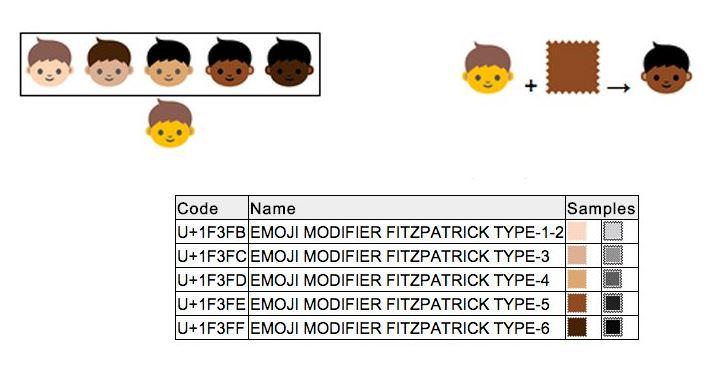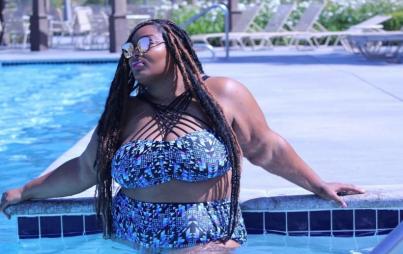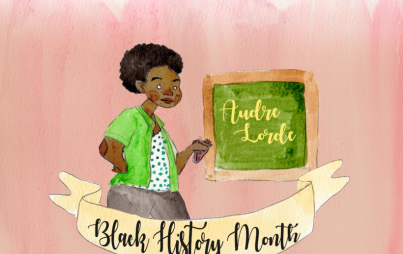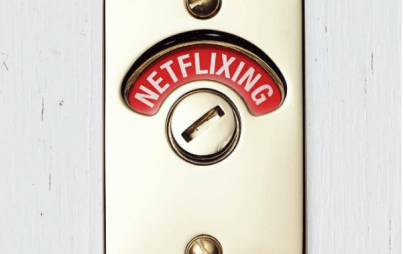
Credit: Unicode emoji report
Emojis are, by their very nature, able to express a gamut of emotions and occurrences central to the human experience.
Unfortunately, they've also historically expressed a whole lot of whiteness.
Since their inception, emoji faces have been predominantly Caucasian. But no more. In its just-released emoji report (yes, that's an actual report real people spent lots of business hours working on), the Unicode Consortium—which sets the international standards for characters like emojis across various software platforms—said it will diversify its roster of characters.
Says the report:
"People all over the world want to have emoji that reflect more human diversity, especially for skin tone. The Unicode emoji characters for people and body parts are meant to be generic, yet following the precedents set by the original Japanese carrier images, they are often shown with a light skin tone instead of a more generic (inhuman) appearance, such as a yellow/orange color or a silhouette."
To that end, developers are adding characters with skin tones based on the six tones of the Fitzpatrick scale, a dermatology standard. Yes, it's a little astonishing that it took this long to diversify the symbols. But the change is commendable, especially considering how frequently emojis make an appearance in our daily lives (check out emojitracker.com, which assesses Twitter emoji usage in real time, to see just how crazy prolific these icons are).
In honor of this decision, we decided to dive into the history of the symbols that have, rather confoundingly, captivated the world. This isn't the first time emojis have embraced a more progressive worldview . . . and it certainly won't be the last time they make an appearance in significant or just-plain strange news headlines.
Late 1990s: The Emoji Is Born
In 1998 or 1999 (the exact date is not known), Shigetaka Kurita, an employee at a Japanese mobile company, began developing emojis, colorful images inspired by manga art. This happened several years after the invention of the emoticon smiley face, involving only keyboard strokes, by a Carnegie Mellon University professor in 1982.
Quick primer on the difference between the two for the tech-phobic among us:
Emoji:
Emoticon:
:)
2009: "Emoji Dick" Is Sadly Not What It Sounds Like
Five years ago, Fred Benenson had an idea on the border between brilliant and bananas: translate all of Moby Dick into emojis with the help of Kickstarter and crowdsourcing. After receiving funding from the public, he had each of the book's 10,000 sentences translated three times. These were then voted on by another set of users to determine the best interpretation. The result of this insane project? A $40 black-and-white paperback and $200 color hardcover book released last year. Buy here! (Or don't.)
2012: Same-Sex Couple Emoji Is Introduced
In a precursor to the emoji's latest progressive change, the Apple iO6 introduced the first emojis depicting gay and lesbian couples holding hands just a few short years ago. Not long after, the Supreme Court historically ruled in favor of gay marriage. Coincidence? We think not.
2012: Burn! Emoticon Creator Slams Emojis
Remember our lesson on emojis and emoticons? Well at one point, things between the two camps got ugly, when the professor who founded the emoticon attacked emojis as "ugly." Alas, this did not escalate into a full-on war of emojis vs. emoticons via a series of furious text messages between the respective founders.
2014: Senator Mark Udall Makes Emoji History
Mark Udall, a Democratic Senator from Colorado, made strange history earlier this year when he used an emoji in an official political press release. His stroke of genius? Use a heart emoji to connect opponent Cory Gardner with the right-wing extremist Ken Buck. Said Udall at the time: It “just seemed like the shortest, simplest and clearest way to show that on issue after issue, Cory Gardner is following the Ken Buck playbook.” Here's the watershed, and pretty damn clever, email in question:
2014: Beyonce And Emojis Unite, Results Are Glorious
Around the exact same time Udall was wielding emojis as a political weapon, Beyonce's steamy "Drunk in Love" music video was set to a series of cheeky, sweet and naughty emojis. And it was amazing.
What will happen next in the saga of emojis? We can't say for sure—but we hope it involves that heavenly mix of continued social progress and Beyonce music videos.






